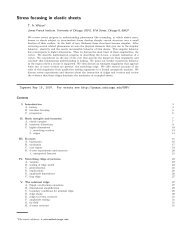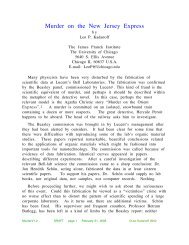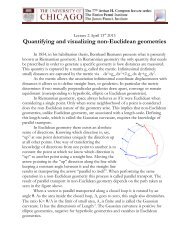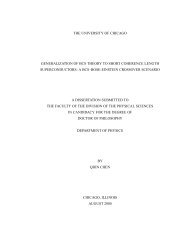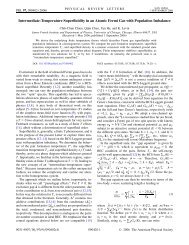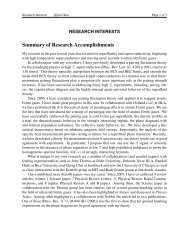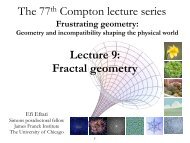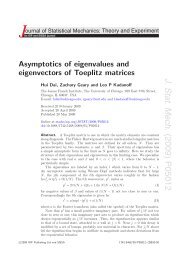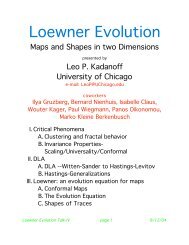Turbulent Heat Flow: Structures and Scaling - University of Chicago
Turbulent Heat Flow: Structures and Scaling - University of Chicago
Turbulent Heat Flow: Structures and Scaling - University of Chicago
Create successful ePaper yourself
Turn your PDF publications into a flip-book with our unique Google optimized e-Paper software.
pt RB DRAFT page 1 May 6, 2001<br />
©Leo P. Kadan<strong>of</strong>f 2001 V4.25<br />
Leo Kadan<strong>of</strong>f (LeoP@U<strong>Chicago</strong>.edu) is a pr<strong>of</strong>essor at the<br />
<strong>University</strong> <strong>of</strong> <strong>Chicago</strong>.<br />
Convective turbulence can be discussed <strong>and</strong><br />
partially understood by focusing upon the<br />
formation <strong>of</strong> plumes <strong>and</strong> boundary layers, by<br />
seeing the statistics <strong>of</strong> fluctuations, <strong>and</strong><br />
noting the possibility <strong>of</strong> the formation <strong>of</strong><br />
different asymptotic ‘phases <strong>of</strong> motion’.<br />
<strong>Turbulent</strong> <strong>Heat</strong> <strong>Flow</strong>:<br />
<strong>Structures</strong> <strong>and</strong> <strong>Scaling</strong><br />
Leo P. Kadan<strong>of</strong>f
pt RB page 2 May 6, 2001<br />
2 Lord Rayleigh, On Convection Currents in a Horizontal Layer <strong>of</strong> Fluid, when the higher<br />
temperature is on the under side, Philos. Mag. 32 529 (1916). H. Bénard, Les tourbillons<br />
cellulaire dans une nappe liquide, Rev. Gen. Sci. Pur. Appl. 11 1261 (1900).<br />
1 A good recent review is Eric D. Siggia, High Ra Number Convection, Annual Reviews <strong>of</strong><br />
Fluid Mechanics 22 137-168 (1994). Many recent references can be found in Siegfried<br />
Grossmann <strong>and</strong> Detlef Lohse, <strong>Scaling</strong> in thermal convection: a unifying theory, J. Fluid Mech.<br />
407 27-56 (2000). For a popular treatment see L.P. Kadan<strong>of</strong>f, A. Libchaber, E. Moses <strong>and</strong> G.<br />
Zocchi, Turbulence dans une Boîte, La Recherche, 22 628-638 (1991).<br />
Geometrical <strong>Structures</strong>: Plumes, Flywheels, <strong>and</strong> More<br />
We want to underst<strong>and</strong> the flow pattern depicted in Figure 1. From studies<br />
<strong>of</strong> other fluid flows, we expect our flow to contain reasonably welldefined<br />
structures, appearing in a mosaic <strong>of</strong> different combinations <strong>and</strong><br />
Turbulence can be seen in the wind <strong>and</strong> the water all around us. Swirls <strong>of</strong><br />
winds are proverbially inconstant. The pattern changes <strong>and</strong> changes <strong>and</strong><br />
changes again. Nonetheless, wind is in some sense always the same. Its<br />
average <strong>and</strong> statistical properties are predictable. There are at least four<br />
strategies which will isolate features <strong>of</strong> turbulent flows for scientific<br />
study. One is to look for the qualitative geometry <strong>of</strong> characteristic<br />
structures which recurringly appear in the flow. The second is to analyze<br />
fluctuations, looking for characteristic probability distributions. A third<br />
is to obtain quantitative characterizations <strong>of</strong> the average flows. Finally,<br />
one can study time series <strong>and</strong> their Fourier transforms. In each case, we<br />
are trying to isolate elements <strong>of</strong> the flow which are open to prediction,<br />
replication, <strong>and</strong> comparison among different systems. We shall look at the<br />
first three here, but put aside the last one for lack <strong>of</strong> space.<br />
For very many years scientists have studied the motion <strong>of</strong> enclosed fluids<br />
heated from below <strong>and</strong> cooled from above1. The containers for these<br />
Rayleigh Bénard systems2 have ranged in size from coke cans to swimming<br />
pools. Usually, as a fluid is heated it will become less dense. A heated blob<br />
will feel a force pushing it upwards, the blob will tend to rise <strong>and</strong> cooler<br />
fluid will fall into its place. At the lowest heating rates there is no<br />
motion. Then as the heating rate is increased one sees successively a<br />
steady motion, a periodic oscillation, <strong>and</strong> a chaotic domain. At higher<br />
heating rates, one finds a turbulent motion in which the fluid swirls in<br />
highly structured but never-repeating patterns. (See Figure 1.)
pt RB page 3 May 6, 2001<br />
So the heat flow has created a ‘machine’ containing many different<br />
working parts: boundary layers, mixing zones, jets, a central region. Figure<br />
4 is a cartoon <strong>of</strong> the machinery at work. Start at the lower left h<strong>and</strong><br />
corner <strong>of</strong> the cell. A wind produces flow progressing from left to right,<br />
<strong>and</strong> carrying with it some waves. Here, the waves are bulges in the height<br />
<strong>of</strong> the thin boundary layer at the bottom <strong>of</strong> the cell. As they move, the<br />
waves throw up a hot spray which tends to rise, forming sheets <strong>of</strong> hot<br />
Figure 1 shows a small container heated carefully <strong>and</strong> uniformly from<br />
below, cooled from above <strong>and</strong> illuminated with a nearly parallel light<br />
beam. Inhomogeneities in temperature bend the light <strong>and</strong> produce the<br />
shadows shown. As you can see, the container is filled with plumes. Hot<br />
plumes congregate in an upwelling jet <strong>of</strong> fluid near the right-h<strong>and</strong> wall <strong>of</strong><br />
the container. A similar, downward jet formed from cold plumes occurs<br />
on the left-h<strong>and</strong> wall. Large numbers <strong>of</strong> hot plumes are also found in left<br />
to right motion in a ‘mixing zone’ or viscous boundary layer near the<br />
bottom <strong>of</strong> the container. A similar layer on the top contains cold plumes,<br />
moving in the opposite direction. The central region contains a few<br />
plumes, hot <strong>and</strong> cold, in a partially r<strong>and</strong>om motion. These plumes w<strong>and</strong>er<br />
chaotically but also participate in an overall counterclockwise motion. In<br />
addition, there are very thin boundary layers, not really visible in the<br />
present picture, near the top <strong>and</strong> bottom walls. The majority <strong>of</strong> the<br />
temperature drop between bottom <strong>and</strong> top <strong>of</strong> the container occur within<br />
these thermal boundary layers.<br />
One structure <strong>of</strong>ten found in heated fluids is called a plume. As heated<br />
fluid rises, it pushes aside fluid above it <strong>and</strong> is in turn deflected by this<br />
pushing. The rising fluid produces a little stalk, like the base <strong>of</strong> a<br />
mushroom, while the deflected fluid produces a cap on top. As the pushing<br />
<strong>and</strong> deflection continue, the edge <strong>of</strong> the cap may further fold over. The<br />
result is something that looks like a mushroom. The nuclear explosion <strong>of</strong><br />
Figure 2 shows a very large plume produced by rising gases. Yet larger<br />
plumes are depicted in Figure 3, which is reproduced from a computer<br />
simulation <strong>of</strong> the surface <strong>of</strong> the sun. This picture shows many cold plumes<br />
falling downward into the sun. More mundane plumes can be seen in a wide<br />
variety <strong>of</strong> laboratory pictures <strong>and</strong> simulations.<br />
ever changing patterns.
pt RB page 4 May 6, 2001<br />
The critical reader will recognize that the analysis up to this point has<br />
been rather subjective. I could have told another story, focusing upon<br />
different features <strong>of</strong> the flow, <strong>and</strong> perhaps come to different lessons.<br />
Nonetheless, a multiplication <strong>of</strong> examples might help the reader believe<br />
that these words catch some properties <strong>of</strong> ‘complex systems’.<br />
Lesson III: Big events happen. The flywheel motion can persist in the<br />
same direction through very many rotations . But once in a while the<br />
motion will reverse itself, in a large <strong>and</strong> quite exceptional event.<br />
Lesson II: Interesting <strong>and</strong> persistent structures can exist <strong>and</strong> persist in a<br />
noisy environment. Here, the structures include both the plumes <strong>and</strong> the<br />
counterclockwise flywheel motion <strong>of</strong> the entire fluid.<br />
Lesson I: A nonequilibrium system can organize itself in an amazing<br />
fashion, producing a sort <strong>of</strong> machine with many different working parts<br />
each serving an apparent function. This natural tendency toward selforganization<br />
might perhaps have some role in creating the intricate<br />
machinery <strong>of</strong> biological systems.<br />
The story: A cell is filled with a fluid. The fluid is strongly heated from<br />
below. Buoyancy raises the heated material <strong>and</strong> a flow starts.<br />
So we have a story <strong>and</strong> a few lessons.<br />
upward motion. These sheets break up into columnar structures which<br />
form the plumes shown in Figures 1 <strong>and</strong> 4. As they move across the bottom<br />
<strong>of</strong> the cell, these structures grow larger. (See Figure 5.) A few plumes<br />
come loose <strong>and</strong> move into the central region. Most hit the right-h<strong>and</strong> wall<br />
<strong>and</strong> move upward as a jet aimed toward the top <strong>of</strong> the cell. As a plume hits<br />
the upper wall, it makes a splash. The splash makes a wave. Each wave<br />
moves along the top, producing cold spray <strong>and</strong> thence cold plumes. The<br />
plumes form into a downward jet at the left h<strong>and</strong> side, splash on the<br />
bottom, <strong>and</strong> produce hot waves....... The jets thus pull the fluid around the<br />
container, forming a liquid flywheel. We find an intricate motion, which<br />
has the seeming purpose <strong>of</strong> moving heat from the bottom <strong>of</strong> the container<br />
to the top.
pt RB page 5 May 6, 2001<br />
3 J Boussinesq Theorie Analytique de la Chaleur (Gauthiers-Villars, Paris, 1903) Vol.<br />
The basic equations:<br />
We do have specific <strong>and</strong> exact knowledge <strong>of</strong> hydrodynamics. We know the<br />
partial differential equations obeyed by any fluid in which variations in<br />
space <strong>and</strong> time are sufficiently slow. These equations describe the flow <strong>of</strong><br />
energy, momentum, <strong>and</strong> particles through the system. They relate rates <strong>of</strong><br />
change in time to rates <strong>of</strong> change in space for velocity, u, temperature, T,<br />
<strong>and</strong> pressure, p. If the density change is sufficiently gentle, the full fluid<br />
equations can be simplified to the Boussinesq3 equations:<br />
2.
pt RB page 6 May 6, 2001<br />
4 For example, (a) Robert M. Kerr <strong>and</strong> Jackson R. Herring, Pr<strong>and</strong>tl number dependence<br />
<strong>of</strong> Nusselt number in direct numerical simulations, Journal <strong>of</strong> Fluid Mechanics (2000),<br />
419:325-344. (b) R. Verzicco <strong>and</strong> R. Camussi, Pr<strong>and</strong>tl number effects in convective<br />
turbulence, J. Fluid Mech. 383 55-73 (1999). (c) R. Camussi <strong>and</strong> R. Verzicco, Convective<br />
turbulence in Mercury: <strong>Scaling</strong> laws <strong>and</strong> spectra, Physics <strong>of</strong> Fluids 10 516-527 (1998). It<br />
is interesting to note how authors <strong>of</strong> simulational papers have adopted the language <strong>of</strong><br />
experimental science. “Several probes are placed inside...” op. cit.. p 517.<br />
where L is the size <strong>of</strong> the container <strong>and</strong> ΔT is the temperature difference<br />
across it. All containers <strong>of</strong> fixed shape <strong>and</strong> obeying the same boundary<br />
conditions will have their flow properties completely determined by these<br />
two numbers.<br />
Another very solid prediction can be made by converting these equations<br />
for the Rayleigh Bénard cell into dimensionless form. For a given shaped<br />
box the equations will then depends upon two dimensionless parameters:<br />
the Pr<strong>and</strong>tl number, Pr, which measures the relative propensity <strong>of</strong> the<br />
fluid to diffuse momentum versus heat, <strong>and</strong> the Rayleigh number, Ra,<br />
characterizing the strength <strong>of</strong> the heat flow driving the turbulence. In<br />
symbols<br />
3<br />
(2) Ra =<br />
g α L<br />
ΔT Pr = υ / κ<br />
Indeed, Figure 3 was generated in a computer simulation using a variant<br />
<strong>of</strong> these equations. From many similar observations <strong>and</strong> simulations, we<br />
certainly know that plumes are a consequence <strong>of</strong> the Boussinesq equations.<br />
coefficient, thermal diffusivity, <strong>and</strong> kinematic viscosity <strong>of</strong> the fluid,<br />
while g is the acceleration <strong>of</strong> gravity. Equations (1) have a very different<br />
status from the ‘lessons’ given above. The equations have been checked<br />
experimentally, studied theoretically, <strong>and</strong> used for many years in<br />
simulations4. They are an essential part <strong>of</strong> our accumulated knowledge <strong>of</strong><br />
fluids.<br />
Here ρ, α, κ, <strong>and</strong> υ are respectively the density, thermal expansion<br />
∇ . u = 0<br />
T + (u ∇ )T = κ ∇<br />
t 2 T<br />
u t + (u . ∇ ) u = − ( ∇ p) / ρ + υ ∇ 2 u + α g T<br />
κυ<br />
(1)
pt RB page 7 May 6, 2001<br />
6 Y.-B. Du <strong>and</strong> P. Tong, Temperature Fluctuations in a Convective Cell with Rough Upper<br />
<strong>and</strong> Lower Surfaces, Phys Rev E 63 046303 (2001). For earlier work see, for example,<br />
references 8 <strong>and</strong> 11.<br />
Phys. Rev. E 49, 2912–2927 (1994).<br />
5 B. Shraiman, E. Siggia, Lagrangian path integrals <strong>and</strong> fluctuations in r<strong>and</strong>om flow,<br />
exponential <strong>of</strong> -|Δ| p . Experiments6 show that just below the onset <strong>of</strong><br />
turbulence, p is two, while p is close to 1.0 in the lower part <strong>of</strong> the<br />
strongly turbulent range (see Figure 7), <strong>and</strong> about 1.5 in a higher range <strong>of</strong><br />
Ra. Smaller p means that big fluctuations are more likely. The increased<br />
likelihood <strong>of</strong> extreme events can have extreme consequences. For<br />
example, if you were an engineer designing an airplane part with a<br />
potential for causing in-flight failure, you might consider it to be<br />
conservative if you designed for safety against all but a ten-st<strong>and</strong>ard<br />
deviation event. Indeed with a Gaussian pattern that event would have a<br />
exponential <strong>of</strong> a constant times -Δ2 . However, in this <strong>and</strong> other turbulent<br />
flows there is an increased likelihood for large fluctuations, which is<br />
indicated by a probability distribution that falls <strong>of</strong>f much more slowly<br />
than a Gaussian. Specifically, the distribution is proportional to an<br />
liberated from far away5 . One can make this point more quantitative by<br />
examining plots <strong>of</strong> the probability distribution for observing a given<br />
temperature as a function <strong>of</strong> the deviation <strong>of</strong> that temperature from its<br />
average value. Since the time <strong>of</strong> Galton <strong>and</strong> Gauss, people have assumed<br />
that under most circumstances the probability distribution for a deviation<br />
<strong>of</strong> size Δ will have a Gaussian form, i.e. that it will be proportional to an<br />
Our convective cell shows another kind <strong>of</strong> anomalously large fluctuation.<br />
The temperature in the central region shows an occasional very large<br />
excursion, probably as the result <strong>of</strong> the occasional passage <strong>of</strong> fluid newly<br />
Statistical patterns<br />
Lesson III above says that we should expect extreme events. In fact, large<br />
excursions are a regular feature <strong>of</strong> the behavior <strong>of</strong> turbulent systems. Our<br />
system has a flywheel motion which undergoes an occasional turnaround,<br />
roughly similar to the occasional turnaround in the earth’s magnetic field.<br />
Many complex things undergo sudden large changes, producing outcomes<br />
like tornados, or earthquakes, or rapid global warming.
pt RB page 8 May 6, 2001<br />
8 B. Castaing, G. Gunaratne, F. Heslot, L.P. Kadan<strong>of</strong>f, A. Libchaber, S. Thomae, X.-Z. Wu,<br />
S. Zaleski <strong>and</strong> G. Zanetti, J. Fluid Mechanics 209 1-30 (1989).<br />
7 Corey S. O’Hern, Stephen A. Langer, Andrea J. Liu <strong>and</strong> Sidney R. Nagel, Force<br />
Distributions Near Jamming <strong>and</strong> Glass Transition, Phys. Rev. Lett. 86 111-114 (2001),<br />
which also contains references to earlier works.<br />
In one such approach, a <strong>University</strong> <strong>of</strong> <strong>Chicago</strong> collaboration8 identified<br />
the different layer regions shown in Figure 4 <strong>and</strong> then estimated typical<br />
velocities, temperature differences, <strong>and</strong> region-sizes to obtain a power<br />
law with β=2/7, fitting the then-existing data <strong>and</strong> some more recent data<br />
(3a) Nu = A Ra β + ...<br />
There are many theories which begin from a picture <strong>of</strong> the different<br />
regions within the convective cell <strong>and</strong> then estimate the order <strong>of</strong><br />
magnitude <strong>of</strong> the various velocities <strong>and</strong> temperature in each region. In<br />
theories <strong>of</strong> this type it is traditional to guess that there is simple scaling<br />
so that one can fit the behavior by power laws <strong>of</strong> the form<br />
Algebraic Features.<br />
The total amount <strong>of</strong> heat flowing upward through the convective cell is<br />
measured by the Nusselt number, Nu, which is the ratio <strong>of</strong> the actual heat<br />
flow to the flow which would occur via heat conduction alone. The motion<br />
<strong>of</strong> the fluid enables Nu to become increasingly large as the Rayleigh<br />
number increases. (See Figure 6).<br />
An exponential tail appears to be a characteristic feature <strong>of</strong> many<br />
physical situations. Exponentials are seen, for example, in force<br />
distributions in glassy materials, foams, <strong>and</strong> s<strong>and</strong> piles7. We do not<br />
underst<strong>and</strong> why they appear so <strong>of</strong>ten.<br />
probability <strong>of</strong> one chance in 1022 or thereabout <strong>of</strong> occurring. That is<br />
almost certainly good enough. With an exponential distribution,<br />
unfortunately, the catastrophic event has a likelihood 1/20,000. A big<br />
difference.
pt RB page 9 May 6, 2001<br />
11 J.J. Niemela, L. Skrbek, K.R. Sreenivasan, R.J. Donnelly “ <strong>Turbulent</strong> convection at<br />
very high Rayleigh numbers” Nature 404 837-840 <strong>and</strong> private communication. These<br />
authors ascribe equation (3c) to Howard, Roberts, Stewartson <strong>and</strong> Herring <strong>and</strong> to J. Toomre,<br />
D.O. Gough <strong>and</strong> E.A. Spiegel, Numerical solution <strong>of</strong> single-mode cavity equation, J. Fluid Mech.<br />
79 1-31 (1977).<br />
Convection, Phys. Rev. Lett. 84, 4357 (2000).<br />
10 X. Xu, K.M.S. Bajaj, <strong>and</strong> G. Ahlers, <strong>Heat</strong> Transport in <strong>Turbulent</strong> Rayleigh-Bénard<br />
9 See also B. Shraiman <strong>and</strong> E. Siggia, <strong>Heat</strong> transport in high-Rayleigh-number<br />
convection, Phys. Rev. A 42, 3650 (1990). On the experimental side see for example Shay<br />
Ashkenazi <strong>and</strong> Victor Steinberg, High Rayleigh Number <strong>Turbulent</strong> Convection in a Gas near the<br />
Gas-Liquid Critical Point, Phys. Rev Lett. 83, 3641-3644 (1999).<br />
A different perspective might be in order. None <strong>of</strong> these equations mean<br />
anything in themselves. To give them meaning, you have to define the<br />
Before choosing it is reasonable to ask “what are we trying to do?”. If our<br />
goal is to get a decent representation <strong>of</strong> the facts observed in a very wide<br />
range <strong>of</strong> turbulence experiments, all three formulas are acceptably good.<br />
from a theory based upon the flow though one ‘optimum’ mode. They also<br />
point to an equally good fit via equation (3a) with β=0.309. All these<br />
proposed formulas match the data to a respectable accuracy. (See<br />
Figure 6.) How to choose?<br />
+ ... ,<br />
(3c) Nu = A Ra 3 / 2 (ln Ra)<br />
Equation (3a) assumed a more or less serial process <strong>of</strong> heat-movement<br />
from boundary layer to mixing zone to central region, while (3b) assumes a<br />
pair <strong>of</strong> processes working in parallel to produce his two terms. Other fits<br />
are possible. Niemela et al11 note a good fit,<br />
(3b) Nu = A Ra 1 / 3 + B Ra 1 / 4 + .....<br />
For example in a recent paper, X. Xu, K.M.S. Bajaj, <strong>and</strong> G. Ahlers10 get an<br />
excellent fit using the Grossmann-Lohse suggestion1 pretty well 9 . Other ‘laws’ seem to do the same job, perhaps even better.<br />
1 / 5
pt RB page 10 May 6, 2001<br />
Shraiman <strong>and</strong> Siggia reference 9.<br />
15 Emily Ching, private communication. See also Grossmann <strong>and</strong> Lohse reference 1 <strong>and</strong><br />
Fluids 5, 1374-1389 (1962).<br />
14 R.H. Kraichnan, <strong>Turbulent</strong> thermal convection at arbitrary Pr<strong>and</strong>tl number Phys.<br />
13 Scientists <strong>of</strong>ten frame their arguments with a view to how the theory might, in the<br />
end, work out. (See for example Stephen Weinberg Dreams <strong>of</strong> a Final Theory (Vintage,1994) )<br />
We imagine that there is an unambiguous answer, that it is relatively simple, knowable, <strong>and</strong><br />
will finally be known. A similar view is presented by almost all detective stories, as for<br />
example, Josephine Tey, The Daughter <strong>of</strong> Time (Berkeley,New York, 1951). However, outside<br />
the sciences, answers are usually more ambiguous--indeed <strong>of</strong>ten unknowable. (See, for<br />
example, Michael Frayn, Copenhagen, (Anchor,2000).)<br />
12 For a novel suggestion in that direction see a recent preprint by Bérengère Dubrulle.<br />
behavior with β=1/2. (plus logarithmic corrections). However, Kraichnan,<br />
<strong>and</strong> more recent authors15 have argued that this “ultimate” regime<br />
asymptotic regimes14 . One regime is very, very high Rayleigh number, with<br />
a non-extreme value <strong>of</strong> the Pr<strong>and</strong>tl number. In that case, Kraichnan said<br />
that highly energetic turbulent events would destroy much <strong>of</strong> the<br />
structure shown in figure 1, <strong>and</strong> give processes in which globs <strong>of</strong> hot fluid<br />
would move from bottom to top in an almost ballistic fashion, trading<br />
their gαΔΤ potential energy for kinetic energy, thereby generating a<br />
One possible description <strong>of</strong> such an eventual theory might be discerned in<br />
Robert Kraichnan’s work <strong>of</strong> 1962, which outlines three different<br />
terms ‘+...’, appearing in both equations. In my view, the right thing is to<br />
dem<strong>and</strong> that the fit become asymptotically accurate. I mean that there<br />
should be some limiting process in which the proposed theory would be<br />
exactly true12. The limiting process would most likely involve having the<br />
Rayleigh number go to infinity, with maybe also having the Pr<strong>and</strong>tl number<br />
going to some extreme value. Alternatively, some fluctuations or<br />
processes might be neglected. Then the ‘+...’ would represent the<br />
corrections to this asymptotic result <strong>and</strong> could be given a well-defined<br />
meaning. So I am suggesting that, to fit the data, one should look forward<br />
<strong>and</strong> guess the form <strong>of</strong> the eventual mathematical theory which will<br />
describe what really happens in the system in some very extreme limit13.
pt RB page 11 May 6, 2001<br />
18 P.-E. Roche, B. Castaing, B. Chabaud, <strong>and</strong> B. Hébral, Observation <strong>of</strong> the power law in<br />
Rayleigh-Bénard convection Phys. Rev E63 045303 (2001).<br />
17 X. Chavanne, F. Chillà, B. Castaing, B. Hébral, B. Chabaud, <strong>and</strong> J. Chaussy,<br />
Observation <strong>of</strong> the Ultimate Regime in Rayleigh-Bénard Convection, Phys. Rev. Lett. 79,<br />
3648–3651 (1997).<br />
16 S. Cioni, S. Ciliberto, <strong>and</strong> J. Sommeria , Strongly turbulent Rayleigh–Bénard<br />
convection in mercury: comparison with results at moderate Pr<strong>and</strong>tl number, Journal <strong>of</strong> Fluid<br />
Mechanics 335 111-140 (1997). See also in contrast T. Takeshita, T. Segawa, J. Glazier, M.<br />
Sano, Thermal turbulence in mercury, Phys. Rev. Lett. 76 1465-1468 (1996).<br />
The theories which characterize the different asymptotic regimes all<br />
include some scaling characterizations <strong>of</strong> the different regions <strong>and</strong><br />
structures within the flow. Thus detailed measurements <strong>of</strong> temperatures<br />
<strong>and</strong> velocities as a function <strong>of</strong> position within the cell can serve to<br />
could tip the convective behavior into different asymptotic regimes 18 .<br />
the same range <strong>of</strong> Ra in which reference 11 finds β=0.309. Such<br />
differences would be underst<strong>and</strong>able if a difference in boundary conditions<br />
Mercury. In Helium, Chavanne, et. al 17 observe a β=1/2 regime in exactly<br />
There is indirect experimental evidence which tends to support the notion<br />
<strong>of</strong> several asymptotic regimes. Different experimental groups can observe<br />
different apparent values <strong>of</strong> the index β. This can even happen when they<br />
are working with the same fluid <strong>and</strong> the same value <strong>of</strong> Ra, but have cells<br />
which differ in geometry or in boundary behavior. Footnote 16 refers to<br />
papers which show such a ‘discrepancy’ for the low Pr<strong>and</strong>tl number fluid,<br />
Pr<strong>and</strong>tl number, which might perhaps describe convection in mercury16 .<br />
According to reference (4b), the difference between the last two regimes<br />
is whether the main heat flow is carried by plumes or by the ‘flywheel’.<br />
Kraichnan is largish Ra (in the range perhaps 108 to 1024 ) <strong>and</strong> high Pr. Many<br />
experiments for convection in water <strong>and</strong> helium fall into this region.<br />
Kraichnan also suggests a third regime, <strong>of</strong> relatively high Ra but low<br />
requires tremendously high Rayleigh numbers. Consequently, almost all<br />
actual experiments should be understood as being in different asymptotic<br />
regimes, with more structure in the cell. Another behavior discussed by
pt RB page 12 May 6, 2001<br />
20 See for example, Per Bak How nature works, the science <strong>of</strong> self-organized criticality<br />
(Springer-Verlag, New York, 1996), Murray Gell-Mann The Quark <strong>and</strong> the Jaguar (New<br />
York, Freeman ,1994), Stuart Kauffman, Investigations, (Oxford <strong>University</strong> Press, 2000).<br />
James Gleick, Chaos (Viking, New York, 1987), Goldenfeld <strong>and</strong> L.P. Kadan<strong>of</strong>f, Simple Lessons<br />
from Complexity, Science 284 (1999).<br />
19 See for example Sheng-Qi Zhou <strong>and</strong> Ke-Qing Xia, Spatially correlated temperature<br />
fluctuations in turbulent convection, Phys. Rev. E 63 046308 (2001).<br />
Acknowledgments.<br />
I have had very helpful discussions with Guenter Ahlers, Emily Ching,<br />
Russell Donnelly, Detlef Lohse, Elisha Moses, J. Niemela, Boris Shraiman,<br />
K. Sreenivasan, Victor Steinberg, Penger Tong, <strong>and</strong> Jun Zhang. This work<br />
was supported by the NSF via the MRSEC program <strong>and</strong> a DMR grant.<br />
Lessons from Complexity<br />
In recent years, there has been much discussion <strong>of</strong> the nature <strong>of</strong><br />
complexity in physical systems.20 At one time, many people believed that<br />
the study <strong>of</strong> complexity could give rise to a new science. In this science as<br />
in others, there would have been general laws, with specific situations<br />
being underst<strong>and</strong>able as the inevitable working out <strong>of</strong> these laws <strong>of</strong><br />
nature. Up to now, we have not found any such laws. Instead, studies <strong>of</strong><br />
specific complex situations, for example the Rayleigh Bénard system,<br />
have taught us lessons, homilies about the behavior <strong>of</strong> systems with many<br />
independently varying degrees <strong>of</strong> freedom. These are general ideas which<br />
one can apply broadly, but require care <strong>and</strong> good judgment. These<br />
experiences encourage us to expect richly structured behavior, with abrupt<br />
changes in space <strong>and</strong> time, <strong>and</strong> some scaling properties. We have found<br />
quite a bit <strong>of</strong> self-organization <strong>and</strong> we have learned to watch out for<br />
surprises <strong>and</strong> big events. So even though there is apparently no science <strong>of</strong><br />
complexity, there is much science to be learned from these studies. Most<br />
<strong>of</strong> all, we have learned that no theory <strong>of</strong> everything can include every<br />
interesting thing.<br />
distinguish among the possible theories <strong>and</strong> regimes19 . Unfortunately,<br />
these measurements are very difficult to perform at the highest values <strong>of</strong><br />
the Rayleigh number.
pt RB page 13 May 6, 2001<br />
being divided by (Ra) 2/7 . The experimental data is shown by red circles<br />
<strong>and</strong> is obtained derived from reference 11. The power law has β=0.309 as<br />
suggested by these authors. The other two curves are <strong>of</strong> the form indicated<br />
in equations (3b) <strong>and</strong> (3c). In each case the fitting curves have been rigidly<br />
displaced from their best (least squares) value so as to better show <strong>of</strong>f<br />
the data.<br />
Figure 6. Ra-Nu relations. In each case the Nu-values are ‘compensated’ by<br />
Figure 5. Plumes move across a bottom boundary layer <strong>and</strong> hit a side wall.<br />
This visualization is taken from B. Gluckman, H. Willaime, <strong>and</strong> J. Gollub<br />
“Geometry Of Isothermal And Isoconcentration Surfaces In Thermal<br />
Turbulence” Phys Fluids A-5 647-661 (1993).<br />
Figure 4. Cartoon view <strong>of</strong> Rayleigh Bénard cell. This picture is partially<br />
based upon a cartoon by G. Zocchi, E. Moses, A. Libchaber, in Physica A 166<br />
(1990) p. 397. See also the description <strong>of</strong> the motion in X.-L. Qiu <strong>and</strong> P.<br />
Tong, Large Scale Velocity <strong>Structures</strong> in <strong>Turbulent</strong> Thermal Convection,<br />
preprint 2001.<br />
Figure 3. Computer simulation <strong>of</strong> the temperature pattern near the surface<br />
<strong>of</strong> the sun. The darker colors indicate lower temperatures. Notice the many<br />
falling plumes near the surface. Simulation by Andrea Malagoli, Anshu<br />
Dubey, <strong>and</strong> Fausto Cattaneo.<br />
Figure 2. Plume produced by thermonuclear explosion ‘Joe 4', August 12,<br />
1953.<br />
Figure 1. Picture <strong>of</strong> a fluid heated from below, Jun Zhang, S. Childress,<br />
Albert Libchaber, Non-Boussinesq effect: Thermal Convection with broken<br />
symmetry. Physics <strong>of</strong> Fluids 9 1034-1042 (1997). The fluid is glycerol <strong>and</strong><br />
has a Pr<strong>and</strong>tl number <strong>of</strong> order <strong>of</strong> hundreds <strong>and</strong> a Rayleigh number <strong>of</strong><br />
2.3×108. The bright lines show regions <strong>of</strong> rapid temperature variation. The<br />
fluid is seen to contain many plumes, especially near the walls. The fluid<br />
moves in a counterclockwise flow.<br />
Figure Captions
pt RB page 14 May 6, 2001<br />
Figure 7. Fluctuation probability. Plot <strong>of</strong> probability for observing a<br />
temperature fluctuation versus normalized fluctuation size. Taken from<br />
reference 6 figure 2.



